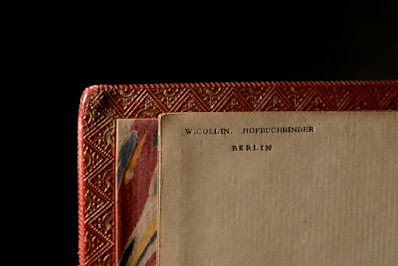CREATIVE FEMALE HANDS
Miss Master Bookbinder
As in so many professions dominated by men alone, women have also turned to bookbinding. In the workshop of Maria Lühr, Berlin, where only female hands exercise the craft, artistic and tasteful book bindings are created under the direction and the own hands of this woman.
The products of this unique female bookbinding workshop will soon be shown in America as part of an exhibition of German women craftsmen in St. Louis and Chicago.
Apprentices inserting the books into the hand press for "backing" and placing the finished books into the standing press.
Copyright by Presse-Photo G.M.B.H.
Berlin SW. 38 -- Wilhelmstr. 130
 |
| Apprentices inserting the books into the hand press for "pressing" and placing the finished books into the standing press. Also seen at far left is the "forgotten Bauhaus stool" manufactured by Rowac in Chemnitz", Germany. |
 |
Schaffende Frauenhände Fräulein Buchbindermeister Wie in so vielen vom Manne allein beherrschten Berufen, hat sich die Frau auch dem Buchbinderhandwerk zugewardt. In der Werkstatt von Maria Lühr, Berlin, in der nur weibliche Hände das Handwerk ausüben, entsehen unter der Leitung und den eigenen Händen dieser Frau künstlerische und geschmackvolle Bucheinbande. Die Erzeugnisse dieser wohl einzig dastehenden weiblichen Buchbinderwerkstatt werden demnächst in Amerika im Rahmen einer Ausstellung Deutscher Kunstgewerblerinnen in St. Louis und Chicago gezeigt werden. Lehrlinge beim Einsetzen der Bücher in die Handpress zum "Abpressen" und Setzen der fertigen Bücher in die Stockpresse. Copyright by Presse-Photo G.M.B.H. Berlin SW. 38 Wilhelmstr. 130 |

























